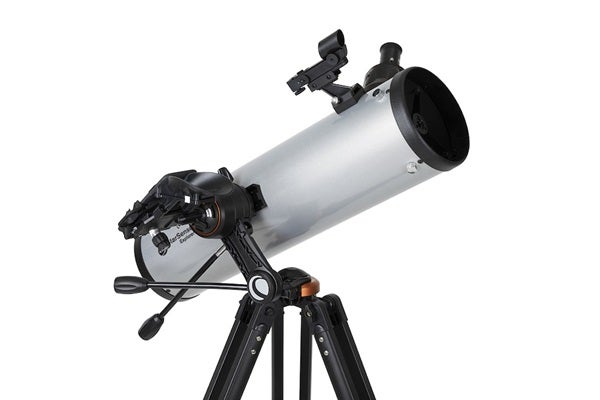
This is a guide to help you learn about some of the best telescopes for beginners, all of which are available at highpointscientific.com.
Choosing the perfect telescope is the first step in a hobby that can last a lifetime. The right telescope can unveil the craters of the Moon, the cloud bands of Jupiter, the rings of Saturn, and other celestial wonders located far beyond our solar system. However, with so many options available, the process of picking the right scope can be overwhelming, especially for newcomers.
Note: This post contains affiliate links. When you buy a product through the links on this page, we may earn a commission.
How we made our picks: To make our selections of telescopes available from our affiliate partner at High Point Scientific, we considered user reviews as well as expert opinions from the Astronomy staff, who together have decades of stargazing experience. For this list, we’ve considered factors such as ease of use, optical quality, and overall value for your money.
Celestron FirstScope 3-inch Tabletop Dobsonian Telescope
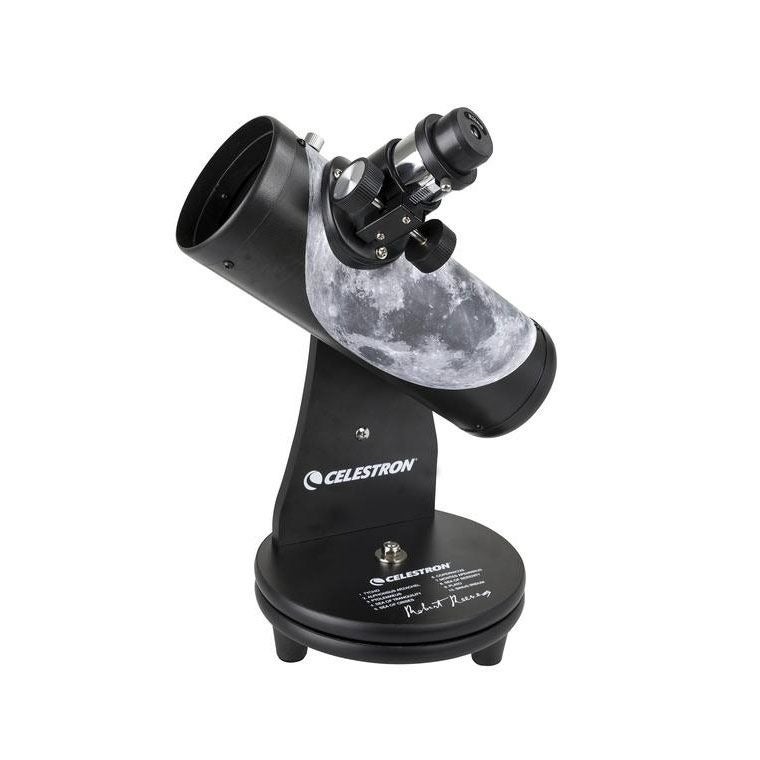
- Features and benefits: This affordable tabletop reflector telescope is compact, easy to operate, and perfect for young beginners. The FirstScope pays homage to Galileo and others in the exterior design.
- Why we like it: It’s an excellent, affordable first telescope that’s designed to be picked up and used with no fuss, making it ideal for children or beginning adults.
- What to keep in mind: Its small aperture size means less light-gathering capability, so it’s best for viewing the Moon and brighter planets.
- Product details:
- Type: Reflector
- Mount: Dobsonian-style tabletop mount
- Aperture: 3 inches (76mm)
- Focal length: 11.8 inches (300mm)
- Price: $49.98
Apertura AD8 Dobsonian 8-inch Telescope with Accessories
- Features and benefits: The Apertura AD8 is a popular choice for beginners due to its excellent light-gathering capability and solid construction. It provides clear, bright images of celestial objects.
- Why we like it: This telescope combines ease of use with powerful performance, which is perfect for beginners who wish to explore deep-sky objects. The included accessories add value and enhance the viewing experience. They include: a full-sized right-angle (RA) image correct 8×50 finder scope, two eyepieces, a 1.25″ adapter to accept both 2″ and 1.25″ eyepieces, a laser collimator, cooling fan, and 1.25″ moon filter.
- What to keep in mind: The size and weight of the Apertura AD8 means it is less portable than many other beginner telescopes. It also requires some space for storage.
- Product details:
- Type: Dobsonian
- Mount: Altazimuth
- Aperture: 8 inches (203mm)
- Focal Length: 47.24 (1200mm)
- Price: $649.95
Vaonis Vespera II Smart Telescope
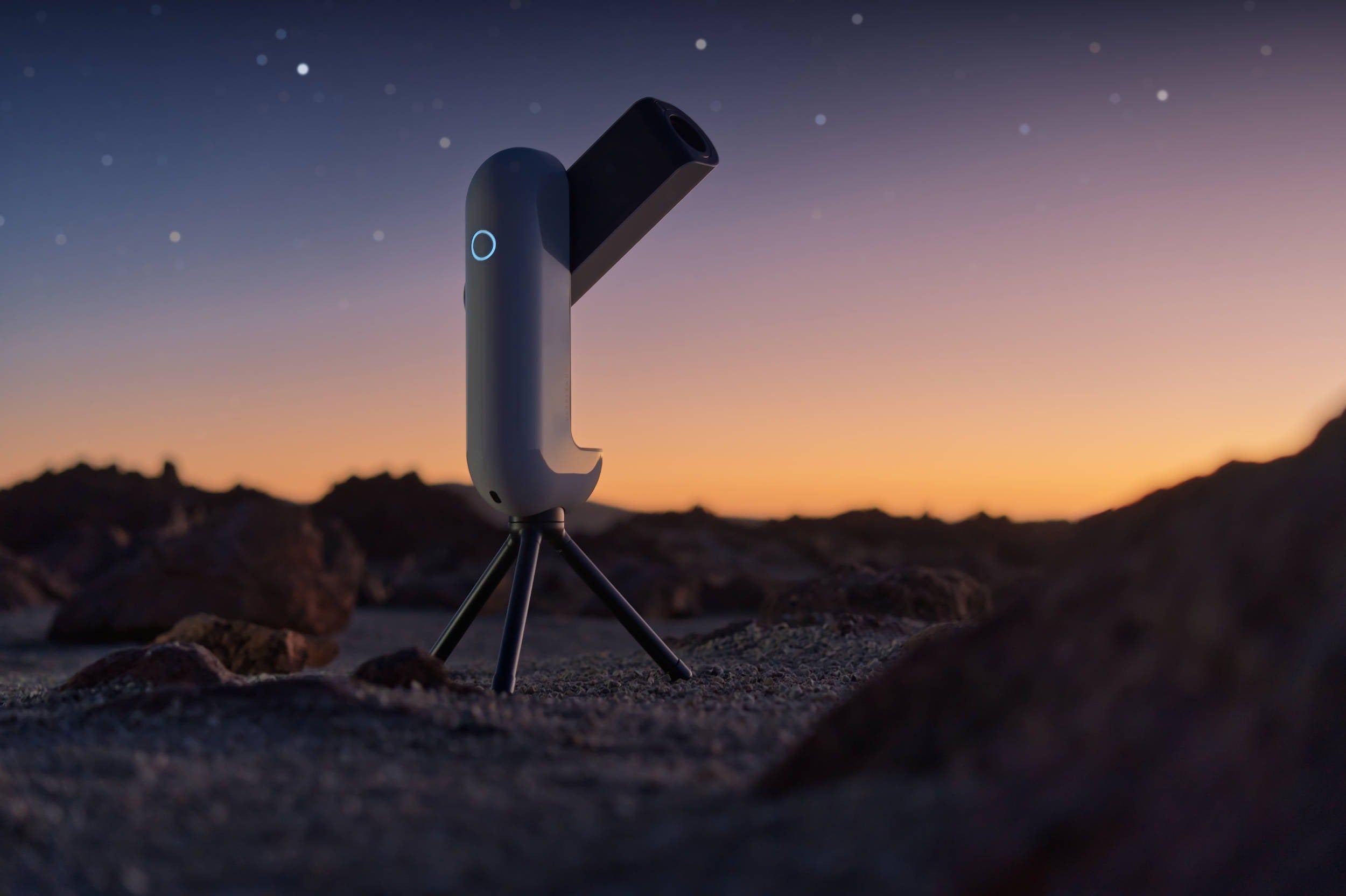
- Features and benefits: The Vaonis Vespera II Smart Telescope combines a telescope and a camera, offering an all-in astrophotography experience. It’s compact, lightweight, and easy to use, making it perfect for beginners. With its automated tracking and imaging system, you can capture stunning images of the night sky.
- Why we like it: This all-in-one observation station is known for its ease of use and the quality of images it can produce, even in light-polluted areas. The Vespera II makes astrophotography accessible to everyone, all without the need for a complex setup.
- What to keep in mind: The Vespera II comes with a premium price tag, reflecting its advanced technology and capabilities. Also, its relatively small aperture might not satisfy those looking for deep-sky observations.
- Product details:
- Type: Refractor
- Mount: Computerized Altazimuth
- Aperture: 1.97 inches (50mm) with integrated imaging sensor (3840×2160 pixels)
- Focal length: 9.84 inches (250mm)
- Price: $1,590.00
Related: Read our in-depth review of the Vespera II, which includes this bottom line from reviewer Raymond Shubinski: “In my opinion, the Vespera is a bargain for the advanced technology available at your fingertips and as an aid for providing beautiful images that can easily be shared with others.”
Celestron Starsense Explorer DX 130AZ Newtonian Reflector
- Features and benefits: The DX 130AZ is ideal for beginners due to its combination of size and smart technology, making navigation of the night sky easier. This scope is particularly well-suited for widefield observing and offers detailed views of planets.
- Why we like it: The integration with the StarSense Explorer app simplifies celestial navigation, making it easy for beginners to track down the targets they want to see.
- What to keep in mind: In order to receive precise navigation instructions, you’ll need to couple a compatible smartphone with the StarSense dock.
- Product details:
- Type: Newtonian reflector
- Mount: Altazimuth
- Aperture: 5.12 inches (130mm)
- Focal Length: 25.6 inches (650mm)
- Price: $479.95
Sky-Watcher Virtuoso GTi 150P Tabletop GoTo Dobsonian
- Features and benefits: The SkyWatcher Virtuoso GTi 150P is a parabolic Newtonian reflector telescope that offers sharp and clear views. It features WiFi control, which lets you use your smartphone as a wireless hand controller. You can see how that works at about the 8:50 mark in the video above. The telescope’s SynScan smartphone app also provides you with an extensive database of celestial objects, further enhancing your stargazing experience.
- Why we like it: This telescope is a nice blend of advanced technology and sizeable aperture. It’s ideal for those beginners who wish to step up their observing game without losing the convenience of smartphone control.
- What to keep in mind: The GTi 150P is slightly heavier than some of its counterparts, which can impact its portability.
- Product details:
- Type: Newtonian reflector
- Mount: Altazimuth
- Aperture: 6 inches (150 mm)
- Focal Length: 29.5 inches (750 mm)
- Price: $470.00
Zhumell Z130 Tabletop Dobsonian
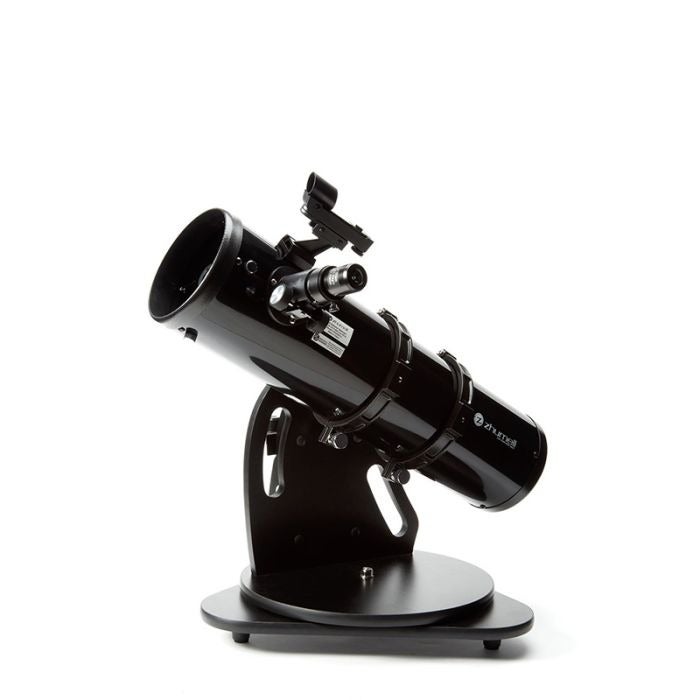
- Features and benefits: This compact Dobsonian is well-suited for beginners, especially younger astronomers, due to its ease of use and portability. It provides excellent light-gathering ability for its size, offering clear views of the Moon, planets, and even deep-sky objects.
- Why we like it: It’s small and light, which makes for impromptu stargazing sessions and easy storage.
- What to keep in mind: Being a tabletop model, it may require a stable surface or additional stand for optimal use.
- Product details:
- Type: Newtonian reflector
- Mount: Portable altazimuth mount
- Aperture: 5.1 inches (130mm)
- Focal Length: 25.6 inches (650mm)
- Price: $399.95
Explore Scientific FirstLight 100mm Maksutov-Cassegrain Telescope
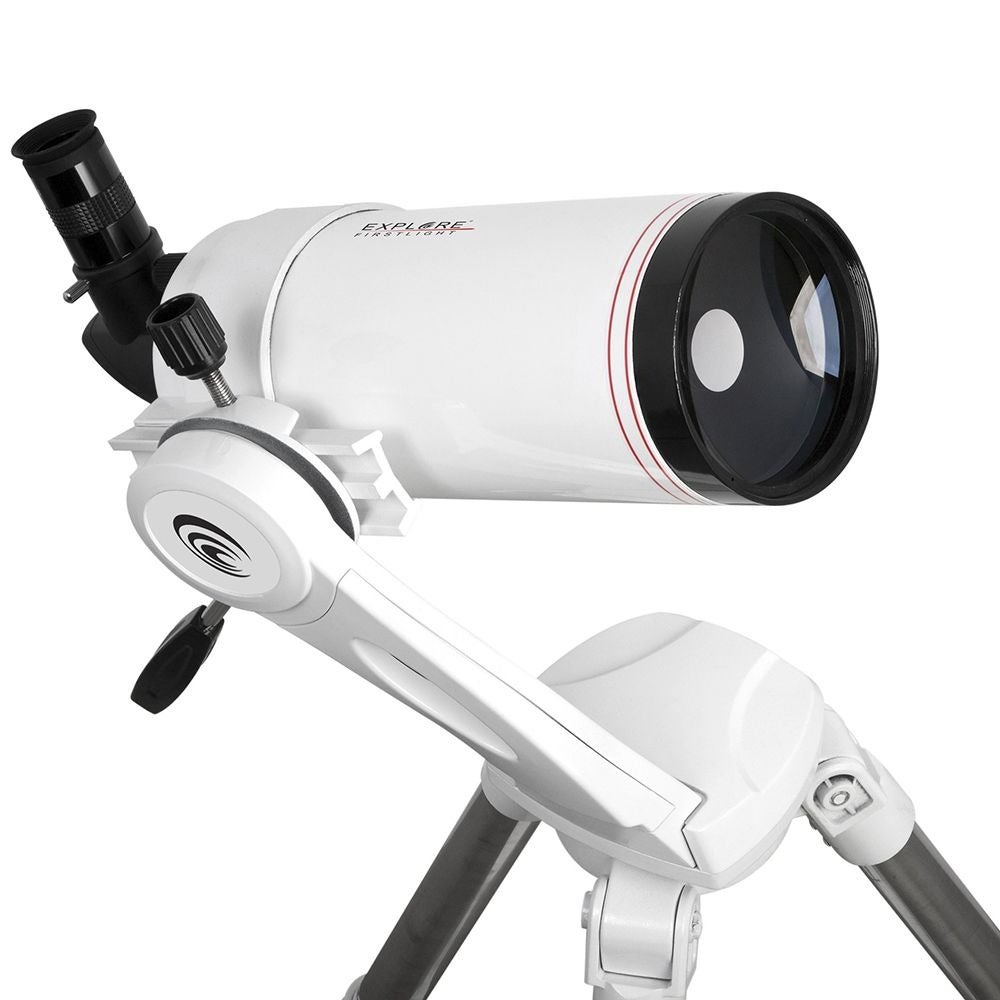
- Features and benefits: This compact telescope is for beginner astronomers who want to combine portability with performance. The compound Maksutov-Cassegrain design offers clear, high-contrast views, making it excellent for lunar, planetary, and double-star observations.
- Why we like it: The FirstLight 100mm stands out due to its easy setup and exceptional clarity, making it suitable for both beginners and experienced users. Its compact form factor is great for those with limited space or who enjoy stargazing on the go.
- What to keep in mind: The narrow field of view may restrict some viewing of expansive deep-sky objects, and additional accessories might be needed to enhance its capabilities.
- Product details:
- Type: Maksutov-Cassegrain
- Mount: Altazimuth
- Aperture: 4 inches (100mm)
- Focal Length: 55.1 inches (1400mm)
- Price: $379.99
Celestron StarSense Explorer DX 102AZ Refractor Telescope
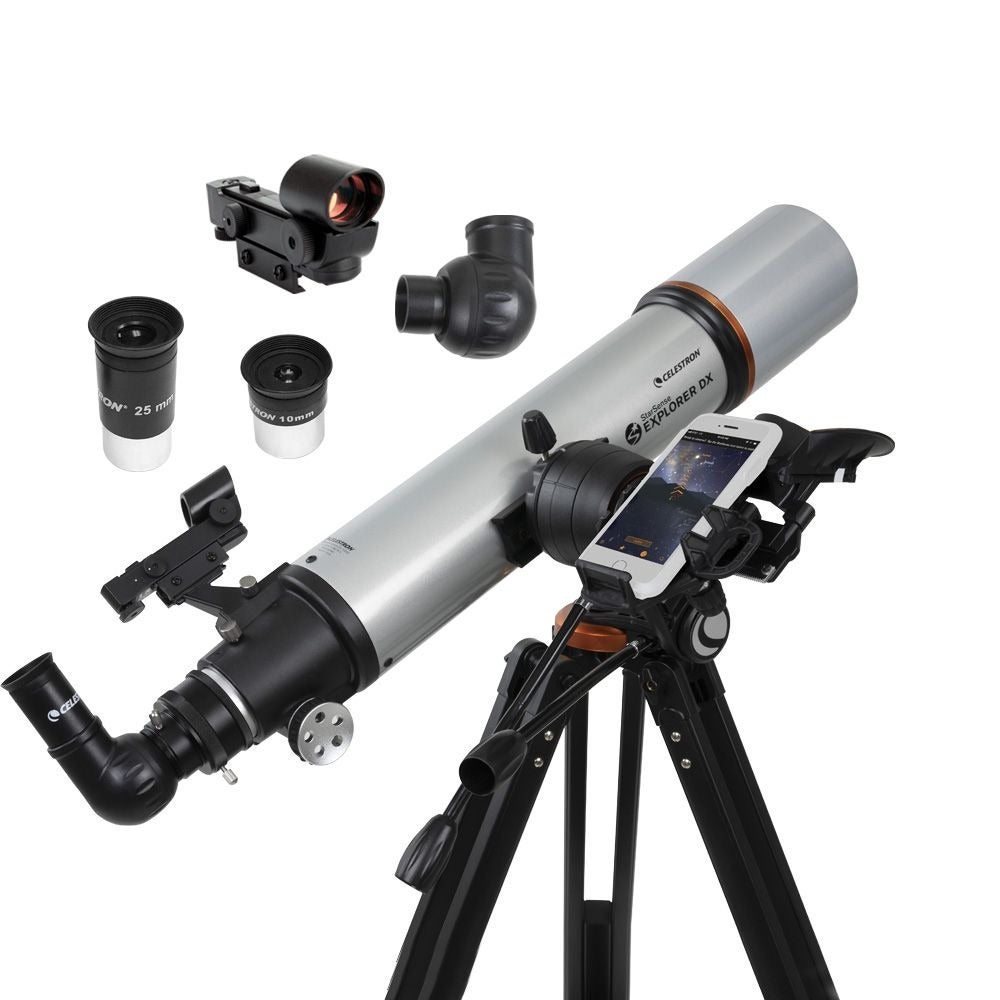
- Features and benefits: This refractor telescope pairs with the StarSense Explorer app to offer easy identification and tracking of celestial objects. It’s perfect for beginners who prefer clear, crisp images, especially of the Moon and planets.
- Why we like it: The Celestron StarSense Explorer DX 102AZ Offers high-contrast views and is less maintenance-intensive than many reflector telescopes. The integration of the StarSense app makes stargazing accessible and straightforward for beginners.
- What to keep in mind: While it offers exceptional clarity, its aperture is smaller than some other beginner telescopes, which may limit deep-sky viewing.
- Product details:
- Type: Refractor
- Mount: Altazimuth
- Aperture: 4 inches (102mm)
- Focal Length: 26 inches (660mm)
- Price: $469.95
The types of telescopes mentioned above
There are three main types of telescopes: refractor, reflector, and compound (catadioptric). Each type has its unique characteristics and advantages, making each suitable for different kinds of astronomical observations.
- Refractor telescopes: Refractors use lenses to gather and focus light. They are known for their durability, ease of use, and for producing high-contrast, crisp images, making them excellent for lunar and planetary viewing. They also tend to require little maintenance. However, refractors can be more expensive and heavier per inch of aperture.
- Reflector telescopes: Refractors use mirrors to collect light. They generally offer larger apertures for the price, making them great for deep-sky viewing. However, reflectors may be bulkier and require more maintenance than refractors.
- Compound telescopes (catadioptric): Compound telescopes combine lenses and mirrors, offering compact and versatile designs like the Maksutov-Cassegrain and Schmidt-Cassegrain. They are good all-rounders and are suitable for viewing a wide range of celestial objects. But they can be more costly.
Factors to consider when buying a new telescope
Below are several key factors you should consider to ensure your stargazing journey starts off on the right foot:
- Aperture size: This is arguably the most important factor. The aperture is the diameter of the telescope’s main optical component and determines how much light the telescope can capture. More light means clearer, brighter images.
- Focal length: This affects the telescope’s magnification and field of view. A longer focal length provides higher magnification and a narrower field of view, while a shorter focal length provides lower magnification and a wider field of view
- Mount type: Telescopes come with different types of mounts — primarily altazimuth and equatorial. Altazimuth mounts are more straightforward and easier to handle, making them suitable for beginners. Equatorial mounts, while offering more precision for tracking celestial objects, have a steeper learning curve.
- Ease of use and portability: If a telescope is too complex or cumbersome, it might deter you from using it regularly. Beginners should look for telescopes that are easy to set up, transport, and store. A good balance between size and portability will ensure more frequent use.
- Additional features and accessories: Look for telescopes that come with additional accessories like eyepieces, a finderscope, or other equipment. These can enhance your viewing experience without requiring immediate upgrades. However, also avoid getting swayed by too many gadgets; focus on the quality of the telescope itself.









